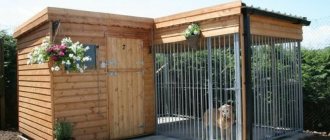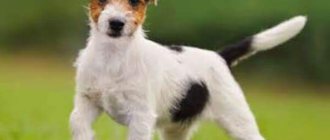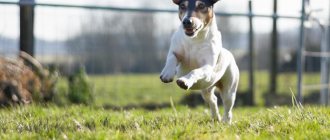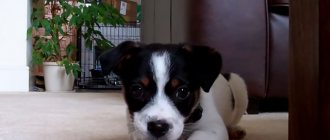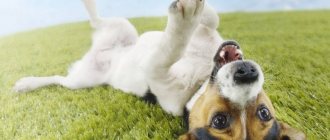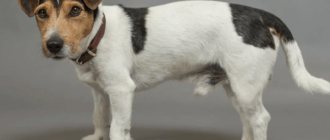Jack Russell Terriers are increasingly being kept as pets.
Their popularity is due to their small size, cheerful disposition and attractive appearance.
However, we must not forget about their true purpose.
These are real hunters and this determines some of the features of their maintenance and care.
How to properly care for your pet?
Let's look into everything in detail.
Puppy care
First of all, the Jack Russell Terrier puppy needs to arrange a personal place where he will relax.
You also need to remove all objects that could injure him and prepare toys for him - this is important for such an active dog, otherwise his energy will find an outlet through damage to the owners’ property.
It is necessary to ensure that the puppy does not jump from a height, does not go down or climb stairs on his own - this can lead to dislocations, bruises or fractures.
Until the teeth are completely replaced, games with tugging should be avoided - they can cause the formation of an incorrect bite.
In the first few weeks, the dog should be fed the same food that the breeder fed it, then the diet can be changed.
Puppies should eat 6 times a day, but as they grow older, the frequency of feedings decreases and by the age of one year the Jack Russell should be switched to two meals a day.
Hygienic care for a puppy includes manipulating the fur, trimming nails, cleaning teeth, eyes and ears . Your pet should be accustomed to all these procedures as early as possible.
Development by months
At one month the puppy already has its first teeth:
- fangs;
- incisors;
- the first and second false-root ones.
He begins to emerge from his den along with the other puppies.
This is the time when you need to start toilet training your dog. During the first month, the breeder observes an increase in the puppy’s activity and how he gets used to his name. The dog develops a daily rhythm.
IMPORTANT! At the age of 45 days it is recommended to brand the puppy. At this time, the baby is also already accustomed to hygiene procedures - combing, cleaning the ears and examining the teeth.
The puppy continues to explore the world. Closer to the age of two months, he begins to better remember commands, chew and ruffle objects around him. He is growing and gaining weight, but at this age it is still impossible to see the puppy’s shortcomings.
Further development occurs in the following order:
- At 2-2.5 months, the puppy begins a period of fear. At this time, you need to communicate with him as much as possible and avoid things that would frighten the dog. Also at this time the puppy is already switching to food. At 2 months, the puppy begins to bark and all of his baby teeth appear. This is the right time to start accustoming him to trips and walks. The dog continues to grow and gain weight;
- from 2 to 5 months, the proportions of the dog’s head and body are determined. Character and teeth change;
- at 3 months the dog is already ready for independent life. During these three months, his individual character traits are formed;
- from 4-8 months the dog begins to want to run away from its owner. This is the time for the dog's "sexy" games. The optimal age to move to a new family. The puppy is fully formed and after changing teeth the bite is visible. At this age, the dog’s character, its preferences and habits are visible;
- at 7-8 months the dog’s growth stops;
- at 8-9 months the dog’s teeth finally change. Fangs that have not fallen out need to be pulled out;
- from 6-10 months the bitch begins her first heat and puberty begins. Males mark their territory and raise their paw;
- 6-12 months is a time of fear of new situations. A new trusting relationship is formed between the dog and the owner. During this period, you should not force the dog to approach the object that it is afraid of;
- at 12 months, the dog completes the formation of the “dominance-submission” relationship.
For an adult dog
As Jack Russells get older, they do not become less energetic, so they still require regular active walks and toys.
It is important to monitor your pet's health.
This includes timely vaccination and deworming, flea and tick treatment, routine veterinary examinations and adherence to nutritional rules.
It is necessary to comb the dog daily, wash its eyes, brush its teeth and inspect its ears for dirt and inflammation.
Expert opinion
Kozhevin Semyon Kirillovich
Expert dog handler.
The main needs of Jack Russells are active walks and proper nutrition. These are hunting dogs, distinguished by strength and endurance; without physical activity, their proper and healthy development is impossible. Food must match their lifestyle and replenish the animal’s energy reserves. Otherwise, caring for Jack Russells is no different from caring for dogs of other breeds and involves regular brushing, trimming of nails, examination of the ears and care of the eyes and teeth.
Grooming
Caring for the coat of smooth-haired Jack Russells does not require serious effort from the owner - they do not need trimming or cutting, or frequent washing.
The only thing that complicates this process is heavy shedding, which lasts throughout the year for dogs living in apartments, in the house, and not on the street..
These dogs need to be combed daily with a rubber brush and once a week with a furminator - a metal comb with thick teeth that gently plucks and combs out dead hairs.
The choice of Furminator depends on the type of Jack Russell coat: for smooth-haired dogs Short Hair is required, for long-haired dogs Long Hair is .
Trimming and grooming
Long-haired or wire-haired Jack Russells, as well as representatives of the breed with an intermediate coat type, require trimming. This is due to the fact that they do not shed.
The hairs, dying, remain on the dog and interfere with the growth of a new coat.
NOTE!
The first trimming is carried out when the dog reaches the age of 4-6 months, during the period of puppy coat change. Then the procedure must be repeated at least 2 times a year.
7-10 days before trimming, the dog should be washed, and immediately before the procedure, thoroughly combed with a furminator..
Exhibition animals need pinching (rolling) 1-2 times a month.
Bathing
The Jack Russell's coat is capable of self-cleaning, so these dogs should be bathed no more than once a month.
Washing your dog too often can dry out your Jack Russell's skin and lead to dandruff..
For washing, you need to use mild shampoos that have a neutral pH, and then use special balms and conditioners that give the coat a well-groomed appearance and shine.
Before bathing, cotton swabs should be placed in your pet's ears to prevent water from getting into them.
After washing, the wool should be thoroughly dried with a towel..
A hairdryer should be used as little as possible - dry hot air dries out your pet's skin.
Wirehaired Jack Russell Terrier
This type of coat is sometimes also called longhaired. If you have such a terrier, then you need to take a responsible approach to care issues. “Gestures” look attractive, they have clearly growing eyebrows and a beard, but they often shed. You can make it easier for your dog to shed, and for yourself to clean your apartment, if you trim the hair in a timely manner.
Interesting: Trimming - trimming the superficial, poorly falling out layer of hair by plucking - a kind of artificial molting. During this painstaking and time-consuming procedure, dead skin particles that tend to provoke allergies are removed.
Jack Russells are accustomed to trimming from 3-4 months. If you do not have experience, then it is better to entrust your pet to an experienced groomer who will perform trimming and also provide a whole list of coat care services:
- the washing up,
- combing,
- haircut,
- treatment with cosmetics for skin and wool.
The procedure should be carried out once every three months, the rest of the time it is enough to comb the dog regularly.
What to do if she sheds a lot?
Shedding is a natural process, but if it is too heavy, you should take your dog to the vet - in some cases, increased hair loss may indicate health problems.
If the examination reveals any disease in the pet, the doctor will prescribe the necessary treatment; if the Jack Russell is healthy, the problem is due to improper care.
It is necessary to review the dog’s diet, change shampoo and conditioner, comb and bathe the pet more often.
Health, tendency to disease
Representatives of the breed are distinguished by good health, which lasts into old age with proper care. The most common genetic diseases:
- Luxation of the eye lens. Characterized by displacement of the lens relative to its normal position (in one or both eyes). Symptoms: lacrimation, photophobia, squinting, abnormal pupil shape. Consequences: complete blindness. Treatment: surgery. During the operation, the position of the lens is corrected or it is removed and replaced with an implant.
- Cataract is a decrease in the transparency of the eye lens. Consequences: visual impairment, complete blindness. Symptoms: cloudy film in the eyes. Treatment: surgical. The affected lens is replaced with an intraocular lens (IOL).
- Patella. Characterized by displacement of the kneecap. Consequences: arthritis, rupture of knee ligaments, immobility. Symptoms: the dog is limping, curling his paw, whining. In the initial stage of the disease, the kneecap returns to its place on its own. In the future, it must be adjusted manually. In the last stage of the disease, the cup does not stay in place.
Treatment: a low-carbohydrate diet (if the pet is overweight), prescription of anti-inflammatory drugs, drugs to restore cartilage tissue; in severe cases, surgical intervention (chondroplasty) is indicated.
- Perthes disease. Manifested by necrosis of the femoral head. Consequences: impaired ability to support the affected limb. Symptoms: lameness, the animal constantly experiences joint pain. Treatment: prescription of anti-inflammatory drugs, adherence to rest. Surgery (joint arthroplasty) is more effective.
- Congenital deafness. The pathology is incurable, but is perfectly compensated by excellent vision and an excellent sense of smell. A deaf dog will be able to adapt and in everyday life will not differ much from healthy animals. She can be quickly taught gesture commands. When walking in open areas, your pet must always be on a leash.
Pet character
Jack Russells have a complex character - they are distinguished by independence, determination, stubbornness, straightforwardness and the ability to independently make decisions based on the current situation.
All these qualities are valuable for a hunter, which is the Jack Russell, but they complicate the training process and require patience and perseverance from the owner when raising a pet.
The hyperactivity and irrepressible energy of representatives of this breed can cause a lot of problems if you do not devote enough time to active walks with the dog..
Jack Russells are cheerful, cheerful, inquisitive, playful and fearless dogs.
IMPORTANT!
They are distinguished by their devotion to their owners and love for children, but they are jealous and aggressive towards animals, especially other dogs.
They are also wary of guests and strangers who trespass on their territory, which is why Jack Russells are good watchdogs.
Equipment (collar, leash or harness)
Even if you have not yet received all the necessary vaccinations and do not plan to take your puppy outside, you must take care of the necessary ammunition in advance.
You can buy a tape measure or leash right away, but the collar should be proportionate to the puppy. Never use a collar for growth. During a walk, a dog may simply “slip out” of a large collar.
But what can you do, since you need to accustom your baby to a collar in advance? There are special collars for growing puppies for this purpose. They are canvas or rag, with the ability to adjust the neck circumference. This is exactly the collar our Jack wore as a child.
Nutrition rules
You can feed Jack Russells with natural products or ready-made industrial food, the main thing is not to mix both types of feeding and monitor the nutritional value and balance of the diet.
Due to the tendency of these dogs to overeat, it is important to monitor the amount of food they consume and adhere to a feeding schedule.
With a natural diet, it is necessary to cook for your pet daily and ensure that the diet consists of 75% animal products. You also need to give your Jack Russell additional vitamins and minerals.
Feeding a Jack Russell with leftovers from a communal table is unacceptable..
In case of feeding with ready-made industrial feeds, additional intake of the vitamin-mineral complex is not required.
The food must be premium, super-premium and holistic and appropriate for the Jack Russell’s age, activity and health status.
Food brands Royal Canin, Acana, Orijen, Hills, Eukanuba, Purina have proven themselves well..
Personal place
The pet's place should be located in a quiet corner of a non-passable room, away from passages, drafts and heating appliances.
It must be equipped with a bedding (blanket, mattress or special bed), the size of which will allow the dog to feel comfortable and stretch out freely during sleep..
If the pet remains in a cage in the absence of its owners, then when purchasing it, you should be guided by the size of an adult dog.
Description
Since 2004, the Jack Russell standard has been in effect.
Main characteristics in the breed description:
- Head - the skull gradually tapers towards the jaws. The muscles of the cheeks are developed. Lips, nose black.
- Teeth – powerful, scissor bite.
- The eyes are almond shaped.
- Ears are mobile and drooping.
- The body is rectangular, the loin is short and muscular. The chest is deep, the volume of the ribs is 40-43 cm.
- The tail is positioned vertically when the animal moves, and hangs down when at rest.
- The limbs are sloping in the front, muscular in the rear. The paws are dense and rounded. The individual moves freely and energetically.
- Wool – protects well from bad weather, smooth.
The size of the animal is strictly regulated: height 25-30 cm, weight of an adult dog 5-6 kg. Deviation from the norm is a disadvantage. Although miniature dogs look funny, they suffer from genetic diseases. The standard is written specifically to breed healthy dogs.
Expert opinion
Anna Abramenko
An avid dog lover. Experience in veterinary medicine since 2009.
Ask a Question
Knowing the dog's height, you can determine how much it weighs. For every 5 centimeters there is 1 kilogram, that is, 30 cm = 6 kg.
Ear cleaning
If your Jack Russell's ears are healthy, as evidenced by the absence of odor, discharge or dirt, and the inside of the ear is light pink, cleaning is not necessary.
If discharge or dirt is found during the examination, they must be removed by soaking a cotton pad or swab in a special lotion and wiping the ears.
Cleaning the ears too often disrupts their microflora, which prevents the entry and development of infections.
If there is heavy discharge, an unpleasant odor, or if the dog scratches its ears a lot, it is necessary to contact a veterinarian for a diagnosis and treatment.
How and why to glue ears?
According to the standard, the Jack Russell's ears should be slightly raised at the cartilages, and the tips should be lowered to the line of the eyes. However, genetic predisposition, excess calcium in the dog's blood, changing teeth, vaccinations and other factors can cause the ears to become straight and high folded.
CAREFULLY!
Perked ears are a serious defect. Such dogs cannot participate in exhibitions and breeding.
If you notice this deficiency in time, it can be corrected. The most suitable age for a pet to install ears is 3-4 months.
There are several methods for gluing ears:
- Taking the dog's ear by the tip and bringing it closer to the outer corner of the eye, determine the fold line. On the outside of the ear, just below this line, stick the patch, leaving a 1-2 cm margin at the edges and repeat the procedure on the inside. To strengthen the bandage, stick on several more layers of plaster, and put a coin between them - it will pull the ear down. Glue the ends of the patch together and carefully trim off the excess.
- The difference from the previous method is that the ear must also be folded lengthwise, forming 2 creases at once: a horizontal one, continuing the line of the skull, and a vertical one, reaching the lower edge of the ear. Apply the patch around the ear in several layers without placing a coin.
- This method is used in case of formation of irregular creases in the fold line. It is necessary to lift your pet's ear, pulling it up by the tip, and stick several layers of adhesive tape on the inside, along the auricle. Determine the fold line, adjust the ear along it, make a fold and fix it.
It is necessary to ensure that there are no diaper rashes on the skin.
If they appear, you should remove the bandage for several days and treat the ears with salicylic alcohol, preventing the spread of bacteria.
How and when to trim nails?
As a rule, the claws of adult Jack Russells wear down on the asphalt on their own during walks. If this does not happen, they should be trimmed with a special guillotine nail clipper every 2 weeks. Puppies require this procedure more often - once every 7-10 days.
Claws that are too long begin to bend and grow in, causing pain to the pet.
As a result of this, the dog places its paws crookedly when walking, which leads to their incorrect formation and incorrect distribution of the load on the joints and ligaments.
Nails should be trimmed carefully, without touching the blood vessels.
Upbringing
There are 3 types of training: burrow hunting, searching for wounded animals, game hunting, including pursuit on the ground. Owners themselves decide which is preferable for their plans.
Training begins at 8-10 weeks of age and takes place in a playful way. With age, classes become more difficult.
They build obstacles and use incentives. The animal is characterized by temperament and unconditional obedience must be curbed.
We invite you to familiarize yourself with: Scotch Terrier (Scottish Terrier) – photo of the dog, description of the Scotch Terrier’s character and characteristics of the breed
Self-confidence, pressure, activity are manifested from a young age. If you let your pet's life take its course, it will educate itself.
The result will be damage to furniture, shoes, carpets, books, and cords. Holes will form in the sofas, and the Internet, TV and washing machine will stop working. Become the leader of the pack, the dog will obey the leader.
Vaccinations and vaccination schedule
Up to 1.5-2 months, the puppy is protected by the immunity received from the mother, then by its own, the formation of which requires timely vaccination.
Vaccinations protect Jack Russells from diseases such as:
- adenovirus;
- hepatitis;
- plague;
- rabies;
- parvovirus enteritis;
- parainfluenza;
- leptospirosis.
To avoid complications and even death, the dog must be completely healthy at the time of vaccination..
7-10 days before the procedure, it is necessary to carry out deworming and treatment for external parasites.
Vaccination schedule:
- 8-9 weeks – 1st vaccination;
- after 2-3 weeks (depending on the chosen vaccine) – revaccination;
- 6-7 months – 3rd vaccination + rabies vaccine.
It is better to note all vaccinations for yourself in the table.
Vaccination and revaccination are carried out with the same drug.
In the future, the dog must be vaccinated annually at the same time.
Walking the dog
The first walks with the puppy should not be long - 10-20 minutes a day is enough..
Over time, you should increase the duration of the walk - as the Jack Russell gets older, it becomes more resilient and it takes more time for him to expend energy, but you should always proceed from the physical condition of the dog.
Regular active walks are the key to your pet’s physical and psychological health, as well as its successful socialization, so you need to walk your Jack Russell every day, regardless of weather conditions.
It is important to remember that representatives of this breed are sensitive to temperature changes, therefore in the cold season they need warm clothes , and in the heat they should choose shaded places for walking .
You can walk your pet only after completing a two-week quarantine after the 2nd vaccination.
Parson aka long-legged
In the history of the formation of the breed, there was real confusion for a long time. It should be noted right away that there is no division of the Jack Russell Terrier breed into long-legged and short-legged.
So why do Russells have different length legs? The answer to this question lies in the fact that the long-legged terrier is a representative of a different breed called the Parson Russell Terrier.
According to the type of coat, the Parson Terrier can be smooth-haired or wire-haired, it always has a good undercoat. The division of the breed into two varieties, Jack and Parson, occurred in 2001. As a result:
- The Jack Russell Terrier has short legs and a strong build, reaching no more than 30 cm at the withers (FCI standard No. 345). The breed was popularized in Australia.
- The Parson Russell Terrier has tall legs and an elegant build; its height at the withers is no more than 36 cm (FCI standard No. 339). The breed was popularized in Great Britain.
The Parson Russell Terrier is faster at running; at one time it took part in horse hunting. It was this quality that made him a favorite of the kingdom of Great Britain, where from time immemorial horses and hunting were signs of aristocracy.
Funny and short-legged Jacks were not held in high esteem in their historical homeland and were practically driven into a corner as an unnecessary breed.
Whatever the appearance of the Russell Terrier, it owes its origin to the founder of the breed, Russell John, a clergyman and an ardent lover of hunting.
And if so, then all Russells are blood brothers and each of them contains the genes of the very dog from which they descended. It follows that they all have typical breed traits and descriptions:
- Character – lively, charismatic, inquisitive, agile, cheerful, loving. Hunting qualities are pronounced.
- Diseases that are inherited are hip dysplasia, congenital deafness, aseptic necrosis of the femoral head (Legg-Perthes disease) and an eye abnormality called “collie eyes” (improper development of areas of the eyes).
- Any Russell Terrier requires regular training, always with physical activity. Possessing increased jumping ability, this breed can perform intricate tricks and does not mind showing off its abilities in agility.
- Feeding Russells, regardless of coat type and leg length, must be of high quality, balanced and portioned, since they are all prone to obesity.
- Tail docking is not mandatory and does not affect the show career of Russell Terriers. As a rule, docking is carried out in early puppyhood to the length of the “grip handle”.
- In the cold season (at temperatures of -5C and below), Jack Russells and Parsons are dressed in clothes. Short-haired varieties of this breed are especially prone to colds.
- Caring for Russells is standard. Comb the coat and trim it if necessary. Take care of your eyes and ears. Vaccinate and treat for fleas and ticks.
- Puppies of this breed up to 3 months of age have practically no signs of future coat structure - this also applies to Jack Russells and Parsons.
- The price of puppies with documents depends on the pedigree of their parents, as well as their exhibition career. It varies from 30 to 80 thousand rubles. Without a pedigree, puppies are sold for 10-20 thousand rubles. Cheaper offers are either culls or crossbred puppies.
There is no point in making a comparison between the Jack and Parson Russell Terriers. They are similar in their bright temperament and tricolor color; they are distinguished only by the structure of their coat and the height at the withers.
Owners of the Russell Terrier breed are unanimous in their opinion that this dog is not suitable for everyone. She needs an active owner who can cope with the complex and restless nature of the hunting terrier. You can find reviews from those who call this breed too hyperdynamic and even extravagant.
Is it necessary to dock the tail?
In accordance with breed standard No. 345, tail docking of Jack Russell Terriers is an optional procedure . There are also no medical indications for her.
Despite this, many breeders prefer to shorten the Jack Russell's tail, arguing that the dog's physique becomes more harmonious and the risk of injuring a limb is minimized (shown in the photo).
When thinking about what to do, it is important to remember that this procedure has a number of significant disadvantages:
- the wound can become inflamed and fester, and an infection can get into it;
- the natural balance of the animal’s body will be disrupted;
- motor skills will weaken.
In addition, tail docking is an inhumane treatment of the animal.
In European countries, Wales, England and Scotland, dogs with docked tails are not allowed to participate in the exhibition.
History of the origin of the breed
The Jack Russell Terrier is a fairly young breed of dog. But their ancestors, fox terriers, have been known since ancient times. You can find drawings and images of small dogs from Roman times. Terriers were used for hunting, and there are now many varieties of them. Russell's homeland is Great Britain. In the 19th century, Pastor John Russell, who was fond of hunting, began breeding hunting dogs. He wanted the perfect dog for fox hunting.
Selection work began with one dog that Russell liked. She was a descendant of English white terriers. It differed from modern Jack Russells in its thin bones and small skull. But the pastor used other breeds: fox terriers, border dogs, beagles, and Scottish cairns. His main goal was the dog's working qualities: intelligence, fearlessness, efficiency, energy, poise, and a clear voice.
No attention was paid to the exterior; the appearance formed on its own. The pastor considered it important only to preserve the white color so that hunters would not confuse the dog with a fox. He bred wire-haired terriers; they turned out to be unsightly and short-legged. Therefore, Russell did not exhibit his pets.
But they quickly became popular and were actively used in hunting. They could track prey, sneak up silently, and climb into a hole. Dexterity and speed made it possible to grab a small animal, and strong jaws made it possible to hold it. These dogs hunt rats better than cats. They understand the meaning of hunting and respond correctly to their owner’s signals. They are used in hunting foxes, badgers, hares, birds, and can follow the scent of a wild boar or deer.
At the beginning of the 20th century, the first club was created, the breed was named after its creator - “Parson Jack Russell Terrier”. Those first dogs were long-legged. Gradually, Welsh Corgis and Dachshunds began to be used for breeding. Such short representatives of the breed were considered defective and would not have become widespread if not for dog breeders from Australia. In the middle of the 20th century, they began to breed short-legged terriers, seeking their recognition.
Only at the beginning of the 21st century were the short Jack Russell Terriers and the tall-legged Parson Russell Terriers separately identified. The dogs turned out to be cute, unusual and very smart. Since that time, Jack Russells began to be used as pets and companions, and can guard the house.
Allergies: symptoms and treatment
The short stature of Jack Russells is the reason for their frequent contact with insects and dust, leading to the development of allergic reactions.
Allergy symptoms are divided into several categories:
- Dermatitis . Rashes and redness appear on the skin, the dog itches, which leads to the formation of bruises. Dermatitis can develop due to dust, pollen, salt, collars, chemicals, mites and other insects; in rare cases, food becomes the cause of the disease.
- Manifestations from the mucous membranes . Most often, allergies affect the mucous membranes of the nose and eyes. The dog has difficulty breathing, increased lacrimation and suppuration of the eyes. This reaction can be caused by dust, food, pollen.
- Swelling . Swelling of individual organs of the animal occurs after a reaction on the part of the skin or mucous membranes and indicates the growth of allergies to dangerous proportions.
Treatment can be emergency or planned.
In emergency treatment, in case of severe swelling or scratching until it bleeds, the doctor prescribes antihistamines, and planned treatment involves eliminating the allergen immediately and undergoing an examination at a veterinary clinic.
Essential Toys
Jack Russells are hunting dogs with strong jaws, so they need chew toys, especially during the teething period. Chew bones and Kongs are good options.
You will also need toys to keep you active, as these energetic dogs need exercise . Flying saucers or discs (Frisbees) are excellent for these purposes.
In addition, Jack Russells love to compete, so they enjoy playing tug. To do this, you can purchase bright rope toys, or use a thick rope, tying knots at both ends.
